Investments in public education require important community decisions. Economic opportunity and growth—for individuals, families, and the city as a whole—are closely tied to how well we educate our children. This guide is designed to help parents and other education stakeholders have a voice in that process.
Public education for students from pre-K through adulthood is offered through two systems in the District of Columbia: DC Public Schools (DCPS) and DC public charter schools. Both sectors receive basic funding based on student enrollment, but the systems differ in how money flows to individual schools and how much autonomy each school has in spending decisions. All schools receive funding to operate, including resources for school staff, instructional programming, and supplies.[1] The two school sectors also receive funding for facilities. DCPS’s capital expenses are funded through the District’s capital budget,[2] while public charter schools receive per-pupil funding for facilities.[3]
This guide is designed to answer the following questions:
- How does the District set its education budget?
- How are individual school budgets set in both sectors?
- How are school facilities funded?
- How can parents and other stakeholders influence school funding decisions during various stages of the budget cycle?
This primer uses budget numbers for the 2019-20 school year for DCPS and DC public charter schools. Where possible, figures for the upcoming 2020-21 school year are provided.
What DC Agencies Are Involved in School Finance?
The Office of the Deputy Mayor for Education (DME) coordinates and implements the Mayor’s vision and strategy for education, including the activities of the Office of the State Superintendent of Education (OSSE) and DCPS. The DC Public Charter School Board (DC PCSB) is appointed by the Mayor and is charged with approving and overseeing the city’s public charter schools. The entities with major roles in financing DC’s public schools are:
-
- Office of the State Superintendent of Education (OSSE): OSSE is DC’s state education agency (SEA) and the District’s liaison to the U.S. Department of Education. Relating to school finance, OSSE:[4]
- Oversees all federal education programs and grants administered in DC
- Ensures high-quality childcare and universal pre-K for eligible DC families
- Provides regional transportation for DC students with special needs
- Awards higher education financial assistance to eligible DC students
- Funds various programs to support public charter school quality
- Department of General Services (DGS): This agency manages construction projects across DC government, including DCPS school construction, maintenance, and repairs.
- District of Columbia Public Schools (DCPS): DCPS, led by the Chancellor, operates 117 traditional public schools serving roughly 50 thousand students.[5] DCPS is the “school system of right,” meaning all students in DC have the right to attend their DCPS neighborhood school and the system must serve all eligible students who seek admission. DCPS is considered a Local Education Agency (LEA) under federal guidelines and allocates funding to individual schools within the DCPS system through its central office.
- District of Columbia Public Charter School Board (DC PCSB): DC PCSB is the sole authorizer of the city’s public charter schools. Those wishing to open a public charter school must be approved by the Board. DC PCSB evaluates public charter schools for academic performance, compliance with laws and their charters, and fiscal management. Per the School Reform Act,[6] DC PCSB can revoke the charter of schools that fail to meet their chosen goals and academic achievement expectations or engage in a pattern of fiscal mismanagement.
- Public Charter Schools: Public charter schools are funded publicly but operated independently. Charter school leaders are given broad authority over their educational model, faculty, and budget, but are expected to meet the goals outlined in their charter, which are negotiated with and approved by DC PCSB. Public charter schools are free and open to all DC students. Each charter school operator—which in some cases manages multiple campuses—is a non-profit corporation run by its own Board of Trustees and is considered an LEA under federal guidelines.
- District of Columbia Retirement Board: Teacher pension plans for all DCPS staff with educational certification are funded through the Teachers’ Retirement Plan, a program run by the DC Retirement Board. DCPS teachers pay into the system and DC government covers any additional funding needed to keep the fund actuarially sound. The amount fluctuates from year to year. For fiscal year (FY) 2020, the city allocated $58.8 million to the Teachers’ Retirement Plan.[7]
- Office of the State Superintendent of Education (OSSE): OSSE is DC’s state education agency (SEA) and the District’s liaison to the U.S. Department of Education. Relating to school finance, OSSE:[4]
Where Do DC Schools Get Funds to Operate?
Public education in the District is funded through several revenue sources, including local, federal, and private dollars.
The Main Source: Local Funds Through the Uniform Per Student Funding Formula (UPSFF)
All publicly funded DC schools get most of their resources from local funds, with the amount determined by the UPSFF and enrollment levels. This formula is used to set the total local funding allocated to DCPS and to each public charter LEA. In FY 2020, some 1.8 billion in local dollars was allocated through the UPSFF. The city allocated $902,522,981 to DCPS and $904,768,857 to public charter LEAs through the UPSFF.[8] The District allocates additional local funds outside of the UPSFF to DCPS.
The UPSFF starts with a foundation level intended to reflect the amount needed to provide general education services for every student. The foundation level for school year 2019-20 is $10,980 per student, with adjustments for students in different grade levels.[9] The UPSFF allocation for a 3-year-old student, for example, is 34 percent above the base foundation, or $14,713 in school year 2019-20.[10] This reflects the smaller class sizes and aides used at the pre-K level.
For DCPS, the UPSFF does not include funding for school construction because modernization funds for DCPS come from the District’s capital budget. Public charter LEAs are required to find and finance their own buildings and are allotted an additional facilities payment through the UPSFF. In FY 2020 public charter LEAs were allocated $3,335 per student for facilities.[11] Public charter LEAs that do not use all the facility fees on facility expenses are allowed to use those funds for other purposes. In contrast, if a charter school has facility expenses that exceed $3,335 per student, they may need to find other sources – such as private funding or their UPSFF operating funds – to meet these needs.
The UPSFF has supplemental weights to reflect the added costs of serving students in special education, English Learners (EL),[12] and students considered “at-risk” of academic failure.[13] For both DCPS and public charter LEAs, the total local funding schools receive is based on the UPSFF amounts multiplied by the number of students at different grade levels and various special needs categories.[14] Below are a few examples of how different categories of students in both sectors saw more funding in the 2019-20 school year:[15]
- Each “at-risk” student carries an additional $2,470 in funding.
- Students with special education needs (who do not need residential placements) are funded an additional $10,650 to $38,318 depending on the level of services they require.
- ELs are funded an additional $5,380 per pupil.
The local funding weights for the 2019-20 school year can be found in Table 1.
In February of 2020, the Mayor proposed a 4 percent increase to the UPSFF for the 2020-21 school year. This increase would result in a base per-pupil funding amount of $11,419.[16] The Council may increase the percentage further or increase certain supplemental weights in the final FY 2021 budget.
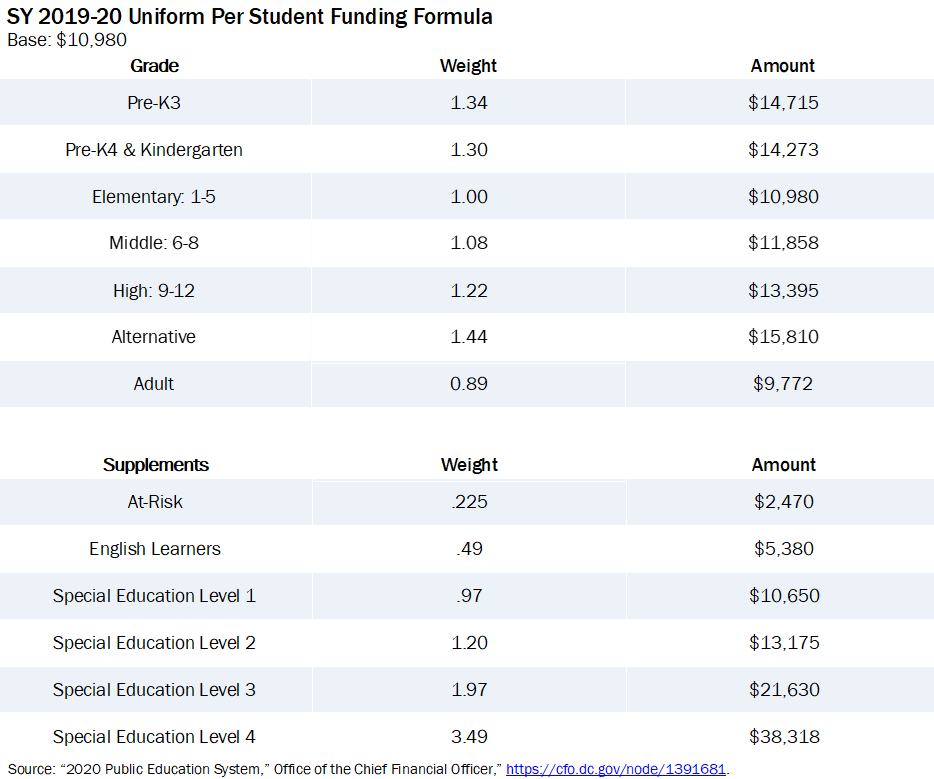
How is the Per-Pupil Funding Level Set?
DC education officials, the Office of the Chief Financial Officer, the Mayor, DC Council, and local education experts designed the UPSFF in 1996. The group priced out a basket of goods to determine a foundation per-pupil cost of an adequate education.
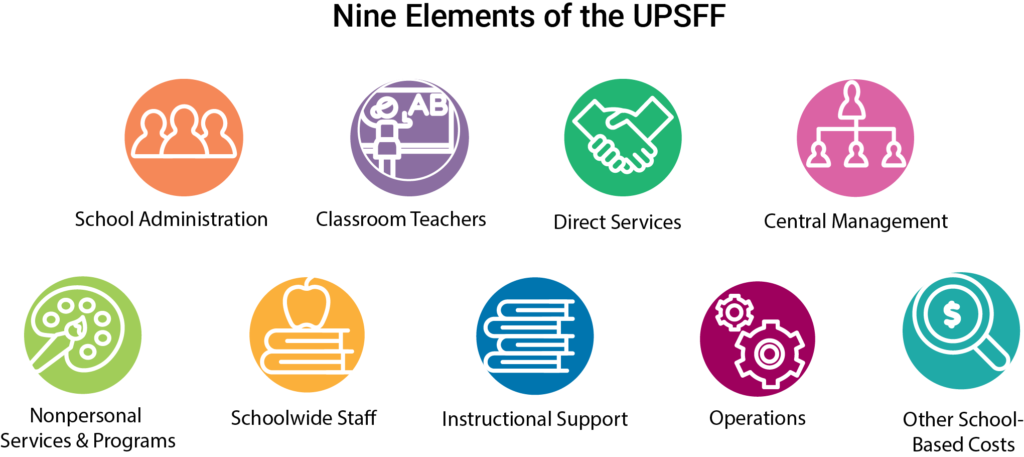
While the costs associated with each of these expenses rises annually, the city does not recalculate the UPSFF each year based on updated prices for these elements. Instead, the Mayor proposes a percentage increase in the UPSFF using a variety of factors, including expected education cost increases and enrollment projections, but also non-education factors like the city’s expected revenues and spending priorities in other parts of the city’s budget. Sometimes the Council further increases the UPSFF during the budget process. If District lawmakers don’t raise sufficient revenue or allocate adequate funds to cover rising education costs, LEAs must make difficult decisions to balance their budgets, such as hiring fewer staff, reducing programmatic offerings, or increasing class sizes.
In 2012, the Public Education Finance Reform Commission was tasked with studying, reporting on and recommending revisions to the UPSFF regarding improvements in equity, adequacy, affordability, and transparency. One of their key recommendations was to produce an adequacy study, which was completed in 2013.[17] The study reassessed the costs included in the UPSFF formula and made several recommendations for changing the UPSFF to better meet the needs of DC students, including increases for certain student categories and the addition of the weight for “at-risk” students. See Figure 1 for a comparison of what was recommended in the study and what has been adopted.
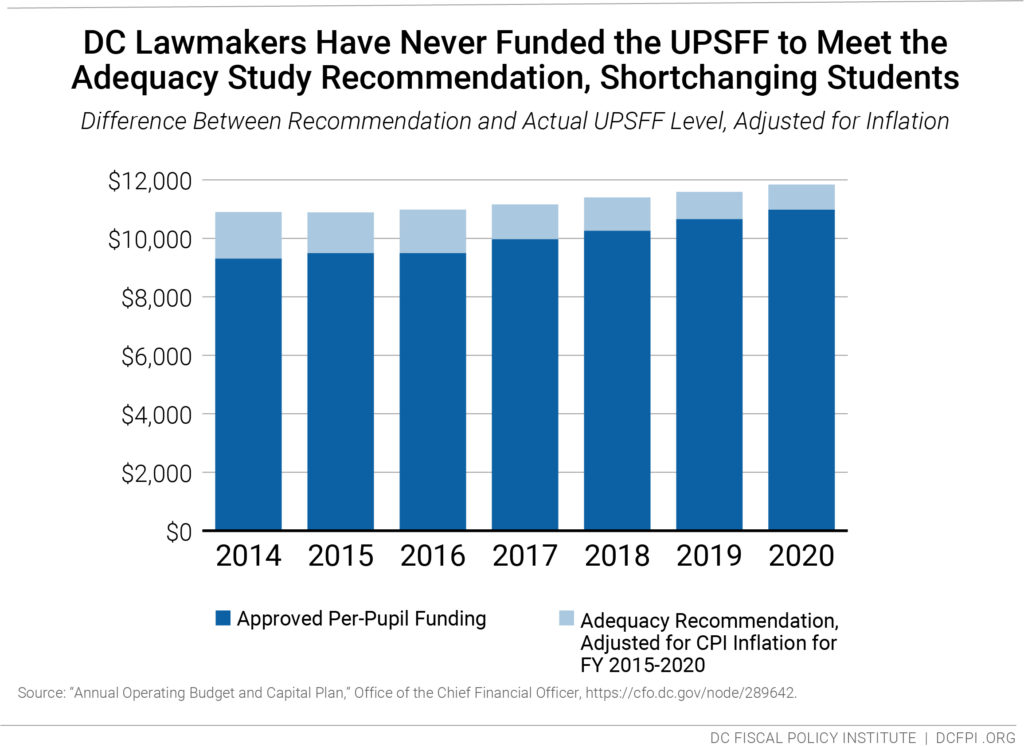
How to Influence the UPSFF
There are many ways for parents, organizations and other stakeholders to advocate so that DCPS and public charter schools have the funding they need to provide a quality education.
Using advocacy to influence the size of the UPSFF is key to getting enough local funding at the school level. The UPSFF should be adjusted each year to keep up with rising costs, but adjustments to it are often driven by citywide budget concerns, not by specific changes in the costs of education.
The Mayor has the most discretion to determine annual increases to the UPSFF—reflecting the mayor’s greater influence over the DC budget generally—and sometimes the DC Council further increase the UPSFF during the budget process.
What School Functions are Paid for by Other DC Agencies Outside the UPSFF?
Certain school functions are not covered by the local resources of the UPSFF, but by other District agencies. For example, school police officers and nurses are staffed by the departments responsible for those functions across the city. Other examples include:
- Some legal services, including those stemming from a special education lawsuit or claim, are provided to DCPS by the Office of the Attorney General (OAG).
- Local funding support from DGS for construction and maintenance for school facilities. Maintenance services include functions such as maintaining cooling and heating systems, roof repair, plumbing repair, and other work to keep school buildings safe and stable for students.
- School resource officers, which are funded by the Metropolitan Police Department (MPD).
- School nurses and mental health professionals are placed in schools by the Department of Health (DOH) and the Department of Behavioral Health (DBH). However, not all public and public charter schools are guaranteed health professionals or school resource officers who are onsite throughout the day. Currently, Children’s School Services Program places school nurses in 110 DCPS and 68 public charter schools.[18]
- The District Department of Transportation (DDOT) provides crossing guards to some schools.
Federal Funds
DC also receives federal funding to support its public education system. Federal grants make up a small percentage of the education budget, but they help finance critical programs.[19] Most federal resources for schools pass from the U.S. Department of Education through OSSE and are allocated to DCPS and public charter LEAs. LEAs are then responsible for disbursing funds to individual schools/campuses. In the case of DCPS, the central office allocates the funding to individual schools, while public charter LEAs with multiple campuses distribute the funding at the campus level. Each federal funding source has a different set of restrictions and guidelines that schools must follow to comply with federal rules and continue to receive those funds.
What Are Some Federal Funding Sources for DC Schools?[20]
Titles I-IV of the Every Student Succeeds Act (ESSA) make up the largest source of federal funding for education. Each title has a set of characteristics that LEAs must meet in order to qualify for the funds. Therefore, Title I-Title IV is not guaranteed to be the largest source of federal funding in any given LEA.
- Title I aims to improve the academic achievement of economically disadvantaged students. DCPS distributes Title I funds to each of their schools with a high poverty rate (at least 35 to 40 percent) while public charter LEAs are allocated Title I funds if their total student population has a poverty rate of 35 percent or higher.
- Title II supports effective instruction through professional development for teachers and other school staff. All LEAs receive some Title II funding based 80 percent on the poverty rate and 20 percent on the LEA’s enrollment.
- Title III supports curriculum and instruction for English Learners. LEAs are eligible to use these funds to serve English Learners and immigrant children and youth.
- Title IV funds student support and academic enrichment. Funds are allocated to LEAs that received Title I funding in the prior year. These LEAs receive an equal proportion of the Title IV pool as they received from the Title I pool. The fund aims to bolster well-rounded education, effective instruction with instructional technology, and safe and healthy schools.
The Individuals with Disabilities Education Act (IDEA) provides the second largest source of federal funding. IDEA is for the education of children with disabilities and requires, as a condition of receiving such funds, that states provide every eligible child with a free appropriate public education (FAPE; i.e., specially designed instruction provided at no cost to the parents that meets the needs of a child with a disability). IDEA funds are allocated to LEAs by formula by the proportion of enrollment of students with disabilities.
Private Funds
DCPS and DC public charter LEAs also look for private funding to boost their budgets each year. For example, the DC Public Education Fund is a non-profit organization that connects DCPS with the philanthropic community. In the past, DCPS secured resources from private foundations to support IMPACT, the evaluation system that offers performance-based bonuses to teachers and school-based staff, but these are now funded through the UPSFF. Some individual public charter LEAs. The DC PCSB Financial Analysis Report includes the philanthropic donations given to each public charter LEA. Many parent associations and other groups raise funds for specific purposes, such as additional staff positions, extracurricular activities, teacher grants, equipment and supplies, social events, and recruitment. Some schools ask parents to pitch in a set amount per year to allow the tuition-free school to continue to offer some services, such as afterschool programs or other activities.
How Does Each DCPS School Get its Funding and Set its Budget?
DCPS schools use operating funding for teachers, principals, supplies, and other functions. Below are the steps involved for an individual DCPS school to receive its operating budget. Capital funding used for DCPS school renovation and construction is discussed later in this guide.
STEP 1: Overall DCPS System Budget. Funding for individual DCPS schools is first affected by the amount of funding the Mayor allocates to the whole DCPS system. As noted earlier, this system-wide figure is determined by multiplying the number of students projected to enroll in DCPS by the UPSFF for the school year. The enrollment projections for each school year are set the prior spring and are based on a city-wide enrollment audit completed in October.
STEP 2: DCPS Allocation Among Major Categories. DCPS then has the flexibility to allocate funding across schools and administrative functions. It tends to do so in three broad ways: central office spending, school support, and direct school funding. See Table 2 below for examples of what falls under each category, as defined by DCPS, along with estimates of dollars spent in each funding category. Note, however, that how DCPS categorizes expenses is subject to interpretation.
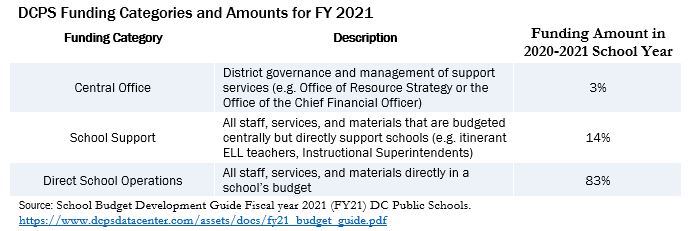
STEP 3: DCPS Allocation to Individual Schools. The funding allocated to each individual school is based on guidelines set by the Chancellor each year and is tied largely to a school’s enrollment and student composition. Each year, these guidelines are released by DCPS in a Budget Guide that outlines the assumptions made and how individual school budgets were created. Along with the guide, the initial school budget allocations are released to school superintendents and principals. The budget guide and individual school allocations for the school year are usually released in March. [21]
The guidelines for directing funding to schools are affected by a number of factors, including requirements in collective bargaining agreements for class size maximums and teacher salary levels, as well as legal mandates to serve students with special education and language needs. Nevertheless, the Chancellor has great flexibility in deciding how to allocate funds to schools, and this can change from year to year.
The main driver of school budgets is the DCPS Comprehensive Staffing Model (CSM).
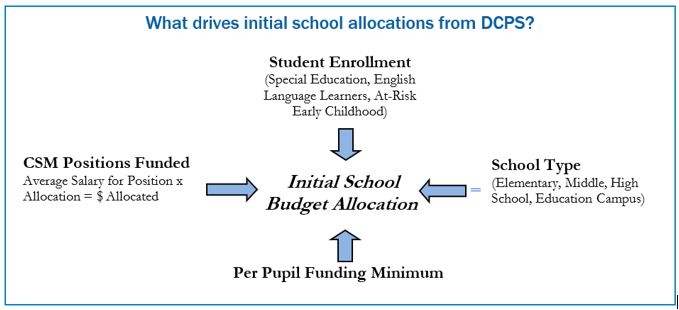
The Comprehensive Staffing Model establishes what positions each school should have (teachers, principals, librarians, etc.) and sets staff-to-student ratios for each position to calculate the number of staff and the funding each school needs to support those positions. For the complete current CSM, see Appendix 1.
Finally, the allocations to schools have been governed in recent years by a separate per-student minimum funding level. If a school’s total funding falls below the per-student floor—$10,400 for the 2020-21 school year—its budget is increased to meet the minimum.[22] Note that this total funding level includes federal and local funding spent on special education, ELs, and Title I, which means that any school with a substantial poverty rate or large number of students with special needs is unlikely to fall below this minimum level to get a funding increase.

The allocations to local schools are divided into required and flexible staffing positions. For example, each school must have a principal and classroom teachers. These are positions the school must fill with part- or full-time staff depending on the school’s size and population. Some flexible positions can be petitioned to be cut, but schools must demonstrate how they will still meet the requirements with the changes in those positions. Other positions are fully flexible for budgeting, and not mandatory.
School-level budgets are built using average compensation—salary and benefits—for that position. Every DCPS school has a Local School Advisory Team (LSAT)—a group of elected and appointed members from the school, plus one community member—to advise the principal on budget decisions. When a school chooses to make staffing changes to the budget proposed by DCPS, the LSAT uses the average salary amount to cover the costs of other staffing or services. For the 2020-21 school year, the average DCPS teacher cost is set at $110,891. This figure is used by central office and schools as they build their individual school budgets each spring, although actual salaries may fall above or below this amount.
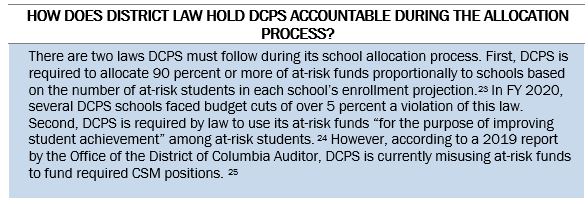
STEP 4: Schools Make Decisions. Added together, these amounts set a school’s budget. Once DCPS has developed the proposed budget allocation for a school, the principal and other school leaders can decide how to spend flexible funds, with some restrictions.
At this point in the process, each school principal is responsible for making critical budget decisions by engaging the Local School Advisory Team (LSAT) in the process. Every DCPS school has an LSAT, a group of elected and appointed members from the school, plus one community member, to advise the principal. The turnaround time before final budgets are to be submitted to DCPS is usually short—around one week.
The school principal reviews the initial school allocation provided by DCPS and identifies what flexible positions the school needs to fund that year based on student enrollment, the school’s goals, and other factors, keeping in mind the list of required positions in the Budget Guide. Principals often use this time to troubleshoot if they believe that the initial budget offered by DCPS does not fully reflect the school’s needs. Principals consult with the LSAT to make these budget decisions before submitting the final budget to the Chancellor’s office.
Appendix 2 shows how an individual DCPS school (Aiton Elementary, Ward 7) made its spending decisions for FY 2020.
How much of DCPS Funding Goes Toward School Support Functions?
Some DCPS services delivered at the school level are not budgeted by the school because they are managed centrally. For example, the “school support” category described earlier includes staff, services, and materials that are controlled by DCPS Central Office, not individual school leaders. Note that DCPS determines the types of services that fall under each of the spending categories (direct school, school support, and central operations) and what goes into the average teacher salary figure, and often changes these from year to year.
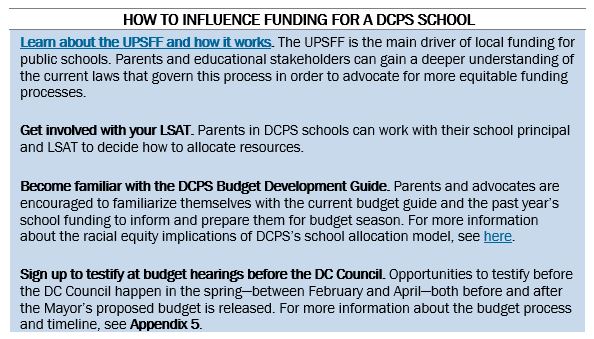
How Does a DC Public Charter School Get its Funding and Set its Budget?
DC public charter LEAs, like DCPS, receive local funding for their enrolled students through the UPSFF. Because public charter leaders have broad flexibility over the use of school funds, there are no required staffing positions across the sector.
Each public charter LEA receives payments from the District on a quarterly basis in July, October, January, and April. This local funding is based on the UPSFF calculation and on the school’s enrollment, which is measured using the audit conducted each October by OSSE. Because schools need to set their budgets before the audit is complete, each public charter LEA receives a quarterly payment over the summer based on projected enrollment for the coming school year. Each public charter LEA’s funding is adjusted after the audit results are completed, usually in January. If the audit identifies fewer students than projected, the district reduces subsequent quarterly payments. If the audit identifies fewer students than projected, subsequent quarterly payments are reduced. Therefore, a charter school that ends up with many fewer students than projected will feel the most financial stress mid-year.
All charter schools operate their own special education programs and report on those services to OSSE. If a public charter LEA ends with more or fewer special education students, or if a student’s special education level changes midyear, OSSE adjusts the payment to reflect student needs.
See Appendix 3 for an example of how one public charter school (Achievement Prep Public Charter School, Ward 8) chose to set its budget in FY 2020.
Each charter school is monitored and evaluated by DC PCSB, which reviews all financial reports and conducts an annual performance management review process for each school. [26]

How Does the Office of the State Superintendent of Education (OSSE) Fit into the Process?
There are two main types of federal education grants that pass through OSSE to LEAs as sub-grants: formula and discretionary grants. Formula funding, which includes Title I, is provided to eligible public schools based on the requirements of that grant. In the case of Title I funding, for example, LEAs are awarded funding based on the share of students who are from families with low-incomes. If the federal funding is a discretionary (also known as competitive) grant, OSSE issues a Request for Proposal (RFP) that allows eligible public schools to apply for funding.
How School Renovation and Construction are Funded and Planned
School facilities funding methods differ greatly between DCPS and public charter schools.
DCPS School Facility Financing
DCPS school renovation and construction are considered long-term infrastructure investments for the city and fall under the DC Capital Budget. Those schools operate in buildings owned and controlled by the District, and DGS manages major repairs and renovations.
In 1995, the District created a Public Education Master Facilities Plan, which launched a strategic process to update or “modernize” DCPS facilities on a regular basis. The latest revision was completed in 2018.[27]
This plan connects to the DC budget process through the city’s Capital Improvement Plan (CIP). The CIP is a six-year plan for capital construction, including schools, with specific projects listed along with their funding and construction schedule. The CIP includes the following types of facilities improvements:
- Modernization and Replacements: Long-term plans for complete renovation of selected schools; the modernization process is tackled in three phases: academic spaces, support spaces, and systems.
- Small Capital Projects: Upgrade of certain sections of a school, such as science labs.
- Component Replacements: Major maintenance, like roof replacements.
- Mandates: Federally required changes, such as improvements related to the Americans with Disabilities Act.
The DCPS capital budget is reworked every year with the rest of the city’s capital budget. It is meant to follow the Master Facilities Plan, but there is not always a strong connection between the two documents. More than three-quarters of DCPS school facilities have been modernized or renovated since 2002. Twenty additional schools are slated for modernization between fiscal years 2019 and 2024. See Appendix 4 for the FY 2020 schedule of school modernization for the District.
Like the other city agencies included in the capital plan, the school capital budget is largely financed with borrowing through general obligation municipal bonds issued by District government. The District pays off these bonds over 20 to 30 years.
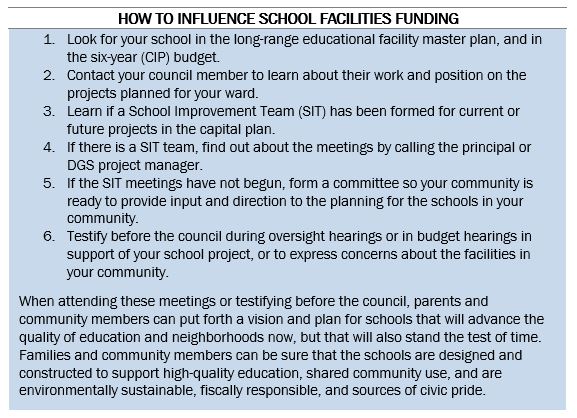
Public Charter School Facility Funding
The city does not provide public charter schools with facilities, so public charter LEAs must purchase and improve their own facilities. Some charter schools lease buildings from DCPS, but most are in other facilities. As of the 2017-18 school year, 31 public charter schools were leasing District-owned buildings, 40 were leasing via private or commercial leases, 22 owned their facilities through private acquisition, while nine owned former DCPS buildings.[28]
In addition to the facility allowance, some public charter schools receive funding for facilities through OSSE’s Office of Public Charter School Financing and Support (OPCSFS), which manages several funding programs and passes federal funding to schools. Programs provide grants as well as credit support for public charter schools doing facility projects or purchasing property.
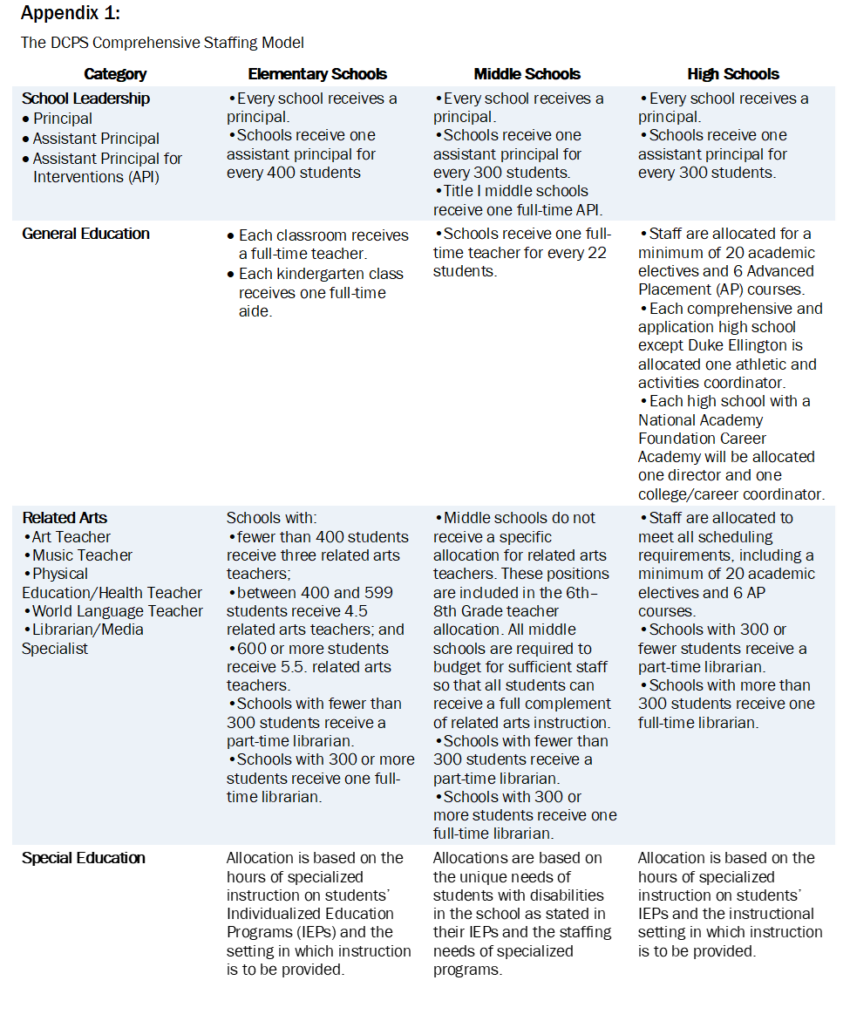
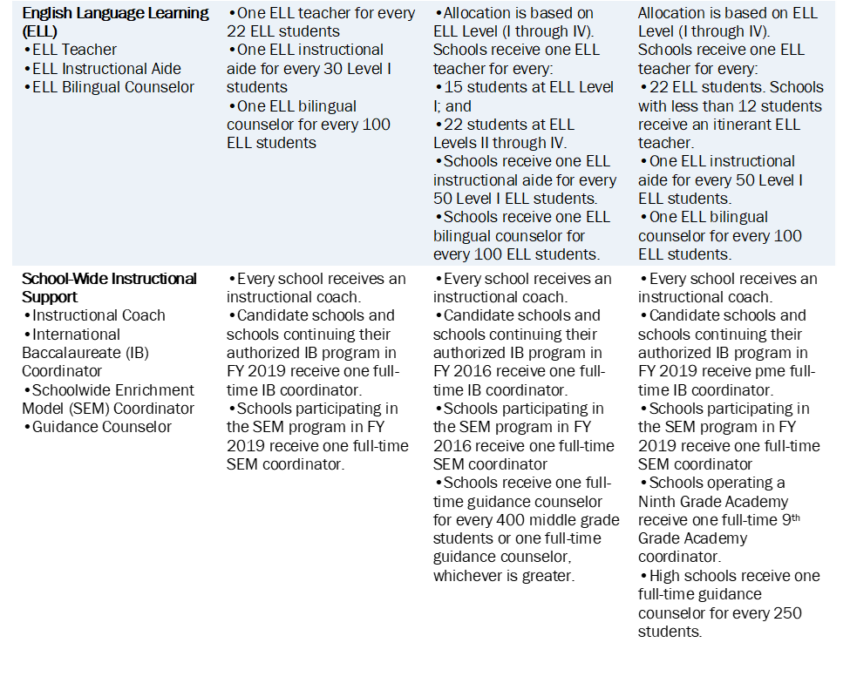
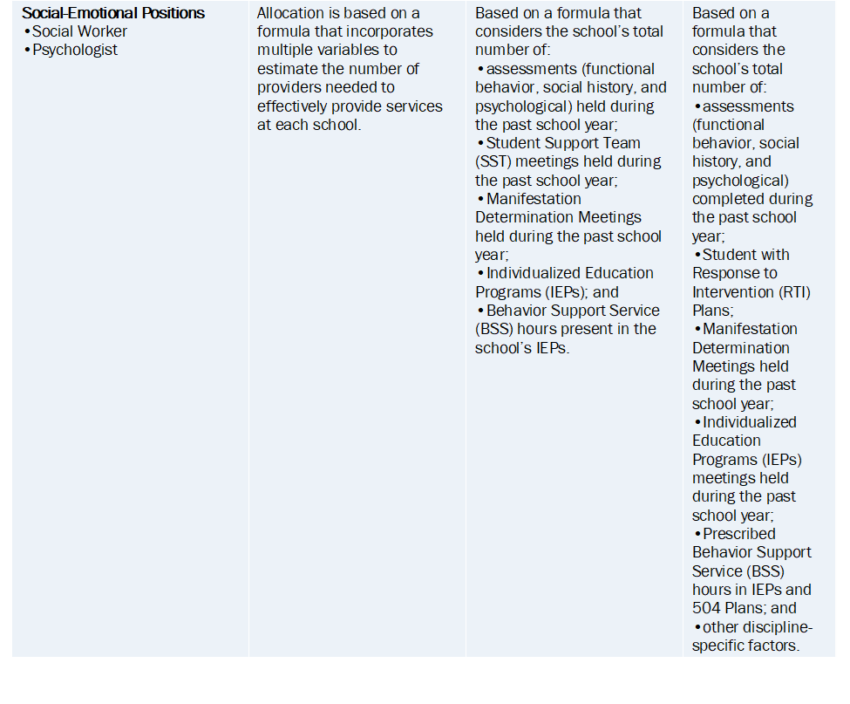
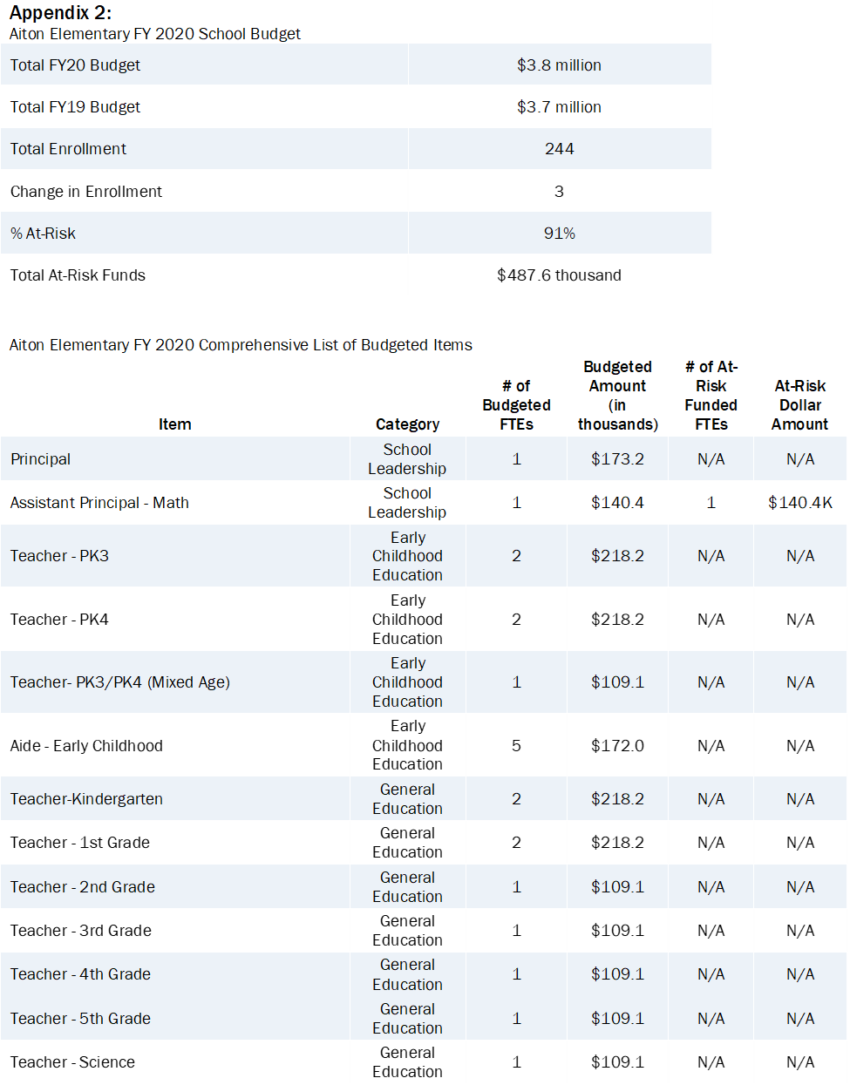
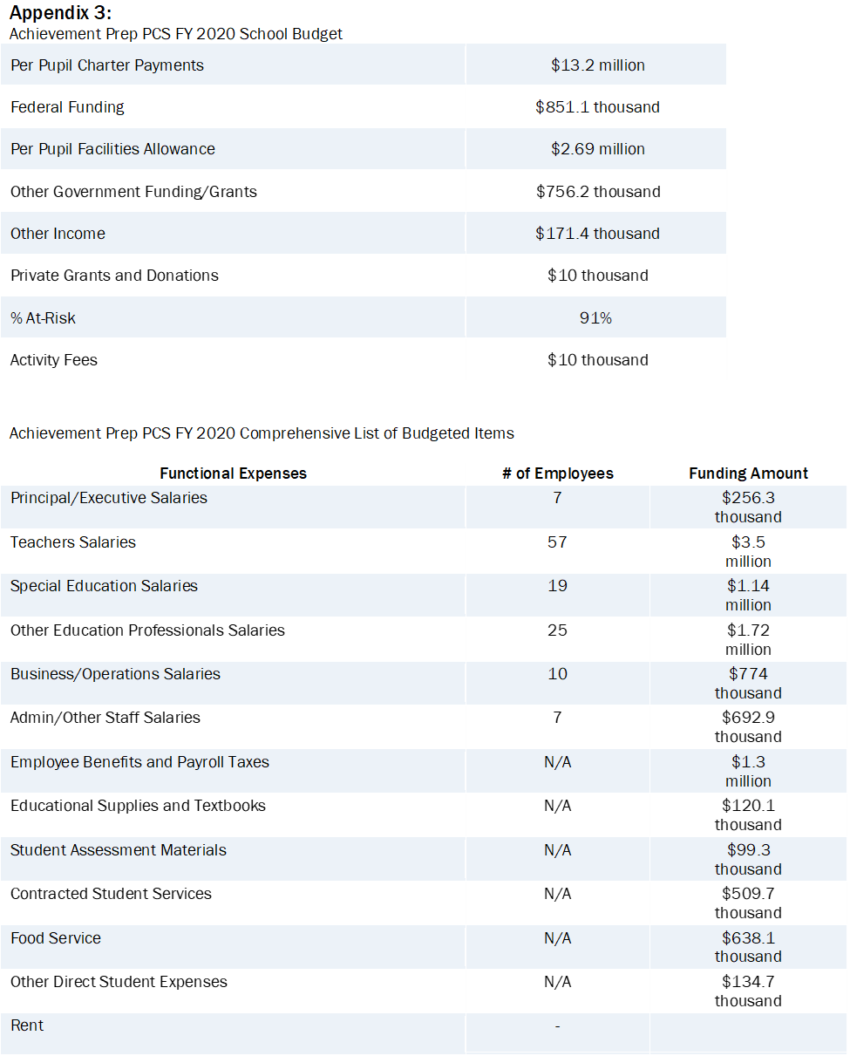
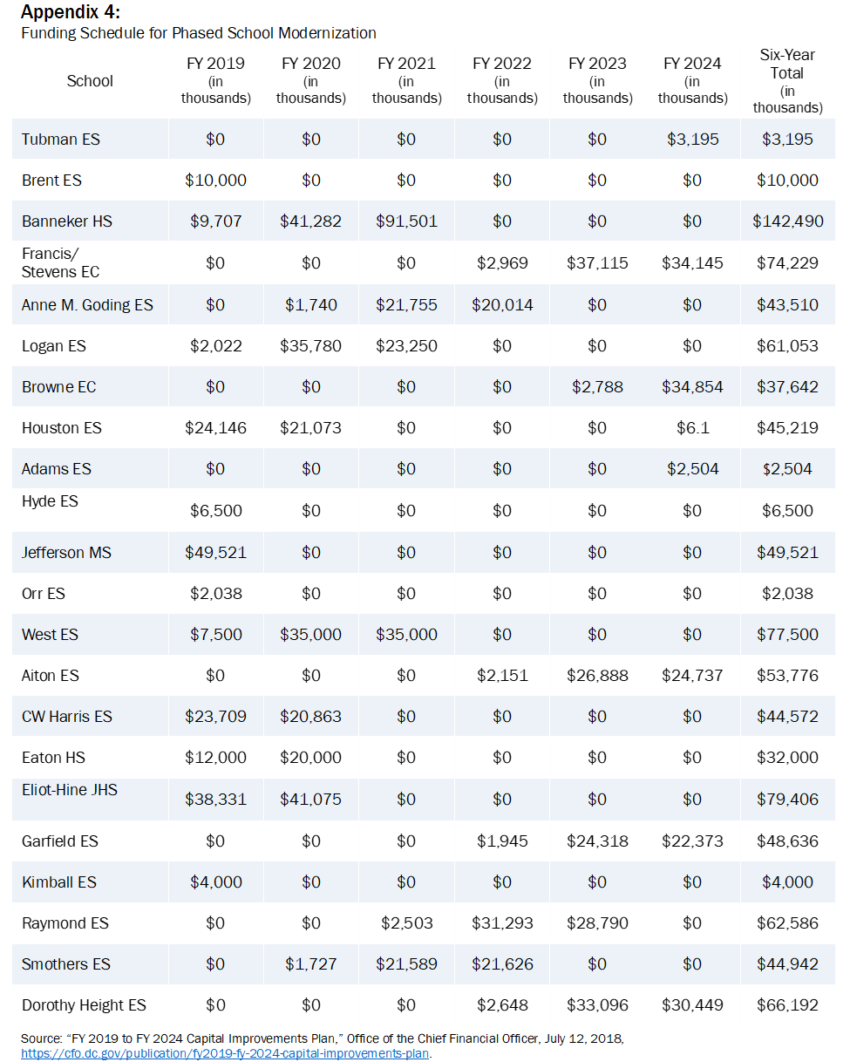
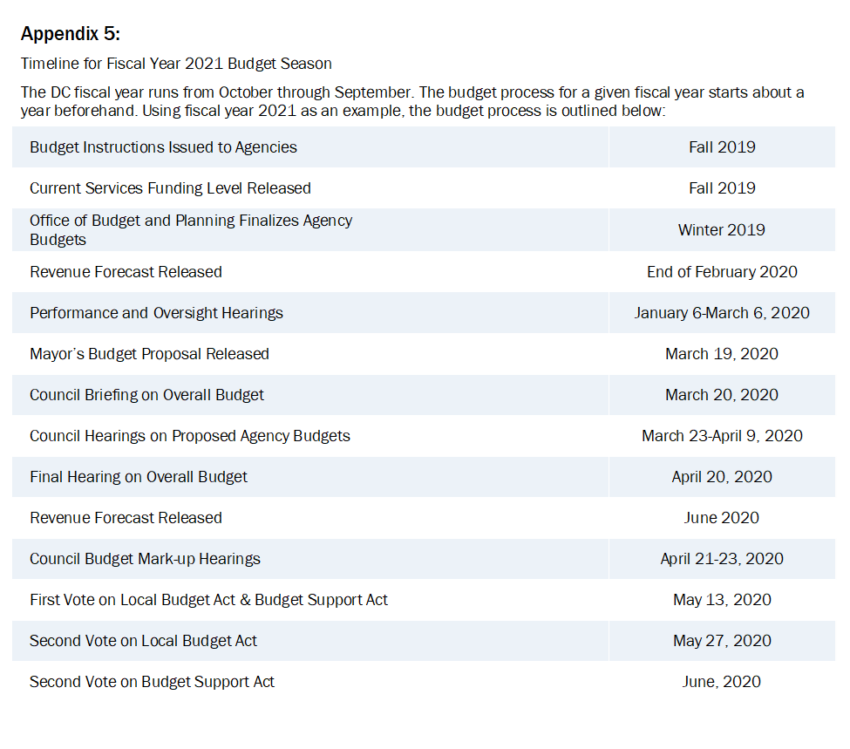
Budget Instructions Issued to Agencies: Fall 2019
The Office of Budget and Planning (OBP) in the Chief Financial Officer’s office issued instructions to each agency that set the terms for the agency’s budget request. The agency requests were submitted back to OBP in the fall using the format set out in the instructions.
Much of the instructions are intended to determine current services funding needs – the amount needed to maintain existing services and meet legal obligations. The current services budget reflects changes in salary expenses, utilities, and other fixed costs.
Agency budget requests also can include suggested enhancements. However, during times of revenue shortfalls, agencies have been instructed not to submit any enhancement requests.
Release of the FY 2021 Current Services Budget: November 2019
The CFO completes work on the FY 2021 current services budget. Ideally, this is an estimate of the costs of maintaining current services, by factoring in changes in costs for salaries, rent, supplies and other expenses. This will not include any funding that was designated “one-time” in the previous year; in the FY20 budget, the Council found $400,000 in funds that they added to the Emergency Rental Assistance program budget as a one-time funding the program will not receive on a regular basis. The current services budget can be compared to the mayor’s proposed budget to look for changes to an agency’s budget. An advocate could take the mayor’s proposed budget and compare it to the current services budget to see what, if any, funding reductions or additions are proposed over what the agency is currently doing.
Note, however, that the CFO stopped calculating a CSFL for schools several years ago. This appears to reflect a lack of support among elected officials. In 2009, DC’s leaders eliminated a requirement for inflation adjustments to the Uniform Per Pupil Funding Formula (UPSFF), the main tool for funding schools. While DC law requires the Mayor to submit an “algorithm” to the Council to explain the specific factors and methodology she uses to determine proposed changes in the UPSFF, the details in recent years have been thin and included considerations beyond growing costs and need, such as revenue availability and other budget priorities.1 The Mayor also recently removed the CSFL figures from her proposed budget documents across all policy areas, further reducing transparency.
Office of Budget and Planning (OBP) “Scrubs” Agencies’ Budgets, Mayor’s Budget Team Begins Assembling FY 2021 Budget: Winter 2019
OBP reviews and “scrubs” each agency’s request. Has all one-time funding from the prior year been eliminated? Does the agency accurately reflect costs associated with expected staffing levels? Does the agency include something in the baseline that should be considered an enhancement?
OBP passes back a modified request to the agency and allows the agency to appeal. This back-and-forth relates mostly to the current services budget. OBP generally does not comment on enhancement requests, since decisions over new initiatives or enhanced funding for existing services are political and made by the mayor. The CFO’s office is independent and avoids policy recommendations. Enhancement requests are passed on directly to the mayor’s office.
At the same time, the mayor’s budget review team is working on assembling the final budget and making policy decisions about cuts and revenue increases.
**POINT OF ADVOCACY** At this time you can contact the mayor’s office to make a request for additional funding (or to maintain funding) for a program or services you care about. Most often, this is easiest to do by finding out who is responsible in the city administrator’s office for the issue area you are concerned about and meeting with them or sending them a letter or email.
Release of the FY 2021 Revenue Forecast: February 2020
In late February, the CFO issues a revenue forecast that includes projected revenues for FY 2021. The budget submitted in March must live within the revenues identified in this forecast.
Council Performance and Oversight Hearings: January 6 – March 6, 2020
The council holds hearings on the FY 2019 performance and the implementation of the FY 2019 budget for every agency. These are free-form hearings that are open to comment on virtually any aspect of the agency. The DC Council Budget Office’s website (http://www.dccouncil.washington.dc.us/offices/office-of-the-budget-director) posts questions that are submitted by committees to the agencies for the hearing, as well as the agencies’ responses.
**POINT OF ADVOCACY** This is a good time to testify on programs and services that you think are working well and help make the case they should be continued or expanded in the upcoming fiscal year. It is also a good time to discuss any changes or improvements you think could be made to the programs and services you care about.
Mayor’s Budget Submission: March 19, 2020
The mayor submits a proposed Budget and Financial Plan, which includes proposed funding to cover the operating costs of running agencies in mid-March. The mayor also submits a proposed capital budget, which is a six-year plan for building and rehabbing government facilities and infrastructure.
The budget legislation that reflects proposed funding levels is called the Budget Request Act. The mayor also submits a Budget Support Act, which includes legislation for any budget proposal that requires a statutory change.
The proposed FY 2021 budget and related documents are posted on the Chief Financial Officer’s website: http://cfo.dc.gov/.
Council Overview Briefing on the Budget: March 20, 2020
Each year, the full DC Council holds a hearing on the mayor’s budget proposal shortly after it is released. Video archives of this hearing, along with other hearings, can be found on the council’s website, www.dccouncil.us.
Council Overview Hearing on the Budget: April 20, 2020
Hearing on entire budget.
Council Budget Hearings, by Agency: March 23 to April 9, 2020
Shortly after the budget is submitted, each committee holds a hearing on the proposed budgets for the agencies the committee oversees. There are both public witnesses and executive branch witnesses. The DC Council Budget Office’s website posts questions regarding the proposed budget that are submitted by committees to the agencies. The budget office also posts the agencies’ responses. The schedule is available on the DC Council website: www.dccouncil.us.
**POINT OF ADVOCACY** This is a good time to testify on elements of the mayor’s budget that you like and elements that you do not like, especially if things are not included at all.
Final Revenue Forecast: June 2020
Early in May, the CFO releases a new revenue forecast. The final budget adopted by the council must fit within this revenue forecast. If the May revenue forecast is lower than the February forecast, the mayor and council must work to find additional budget savings. If the May revenue forecast is higher than the February forecast, the council can support some additional funding proposals.
Council Committee Budget Mark-ups: April 21 to April 23, 2020
Each council committee meets to mark-up the budgets for the agencies they oversee. The committees cannot appropriate more in total for their agencies than the amount in the mayor’s proposed budget, but they can shift funds within and between their agencies. The committees make recommendations for things they are not able to fund, but that they hope the full council will find a way to fund. The committees also adopt recommendations on the Budget Support Act provisions that relate to the committee.
After each committee has completed mark-up, there is a one- to two-week period during which the council members work to merge the committee actions into a comprehensive budget. This work happens behind the scenes. There is no mark-up on the council’s comprehensive budget.
Main Budget Vote: May 13, 2020
The full council (Committee of the Whole) votes on the Budget Request Act, which sets the appropriations level for each agency. There is only one vote on the BRA. Also in May, the council holds its first reading of the Budget Support Act. There is a second reading on the BSA.
Final Vote on the Budget Support Act: May 27, 2020
The council holds the second reading of the Budget Support Act. The budget is then submitted to the U.S. Congress for approval.
[1] D.C. Code Chapter 29. Uniform Per Student Funding Formula.
[2] “FY 2020 to FY 2025 Capital Improvements Plan,” Office of the Chief Financial Officer, July 25, 2019, https://cfo.dc.gov/node/1392936.
[3] D.C. Code 38-2908. Facilities allowance for Public Charter Schools.
[4] “About OSSE,” Office of the state Superintendent of Education, https://osse.dc.gov/page/about-osse.
[5] Perry Stein,“D.C. charter schools experience first enrollment drop since 1996,” The Washington Post, October 22, 2019, https://www.washingtonpost.com/local/education/dc-charter-schools-experience-first-enrollment-decline-since-1996/2019/10/22/95d691f6-f4da-11e9-a285-882a8e386a96_story.html
[6] “District of Columbia School Reform Act of 1995,” District of Columbia Public Charter School Board, August 15, 2019, https://dcpcsb.org/district-columbia-school-reform-act-1995.
[7] “2020 GX0 Teachers’ Retirement System,” Office of the Chief Financial Officer, https://cfo.dc.gov/node/1392186.
[8] FY 2020 Approved Budget and Financial Plan: Volume 1 Executive Summary,” Government of the District of Columbia, https://cfo.dc.gov/sites/default/files/dc/sites/ocfo/publication/attachments/DC_OCFO_Budget_Vol_1_0.pdf, (page 1-11).
[9] For FY 2020, the UPSFF foundation level was increased by 3.0 percent, from $10,658 to $10,890 per student.
[10] “2020 GC0 DC Public Charter Schools,” Office of the Chief Financial Officer, https://cfo.dc.gov/node/1392196.
[11] “2020 GC0 DC Public Charter Schools.”
[12] An English Learner (EL) student is defined as a linguistically and culturally diverse (LCD) student who has an overall English Language Proficiency (ELP) level of 1-4 on the ACCESS for ELLs 2.0™ test administered each year.
[13] The “at-risk” weight adds supplemental funding for students who fall under any of the following categories: is homeless, living in foster care, an over-age high school student, eligible for Temporary Assistance for Needy Families (TANF) or the Supplemental Nutrition Assistance Program (also known as food stamps).
[14] The UPSFF compounds supplemental funding. For instance, students can be classified as both “at-risk” and “English Learner” and receive the additional funding of both categories.
[15] “2020 GC0 DC Public Charter Schools,” Office of the Chief Financial Officer, https://cfo.dc.gov/node/1392196.
[16] Gail Zuagar, “STATEMENT: DC Fiscal Policy Institute Applauds Mayor’s Increase in School Funding,” DC Fiscal Policy Institute, February 3, 2020, https://www.dcfpi.org/press-releases/statement-dc-fiscal-policy-institute-applauds-mayors-increase-in-school-funding/.
[17] The Finance Project, Augenblick, Palich and Associates, “Cost of Student Achievement: Report of the DC Education Adequacy Study,” District of Columbia Deputy Mayor for Education, December 20, 2013, https://dme.dc.gov/page/dc-education-adequacy-study.
[18] “Children’s School Services,” Children’s National, https://childrensnational.org/advocacy-and-outreach/in-the-community/community-partnerships/childrens-school-services.
[19] “Federal Aid to State and Local Governments,” Center on Budget and Policy Priorities, April 19, 2018, https://www.cbpp.org/research/state-budget-and-tax/federal-aid-to-state-and-local-governments.
[20] The authors wish to thank Bonnie Bacon and Jessie Harteis of the Office of State Superintendent of Education for helping to develop this section.
[21] This site includes initial budgets set by DCPS for each school, as well as submitted budgets approved by the school’s LSAT.
[22] “School Budget Development Guide: Fiscal Year 2021 (FY21)” District of Columbia Public Schools, February 2019, https://www.dcpsdatacenter.com/assets/docs/fy21_budget_guide.pdf
[23] DCPS Budget, DC Code 38-2907.01(a)(2), https://code.dccouncil.us/dc/council/code/sections/38-2907.01.html.
[24]DCPS Budget, DC Code 38-2905.01(a)(3), https://code.dccouncil.us/dc/council/code/sections/38-2907.01.html.
[25] Erin Roth and Will Perkins, “D.C. Schools Shortchange At-Risk Students,” June 26, 2019, Office of the District of Columbia Auditor, http://dcauditor.org/report/d-c-schools-shortchange-at-risk-students/.
[26] “School Finances,” DC Public Charter School Board, https://dcpcsb.org/school-finances.
[27] “DC Public Education Master Facilities Plan 2018,” Office of the Deputy Mayor for Education, https://dme.dc.gov/MFP2018.
[28] “DC Public Education Master Facilities Plan 2018.”
